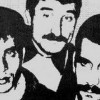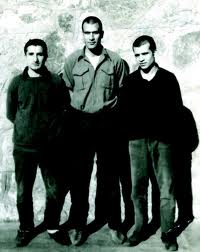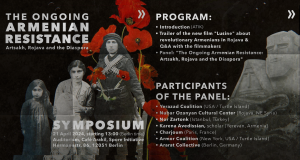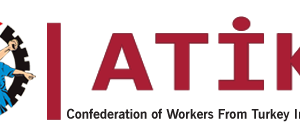 TURKEY | 06-05-2014 | On 16 July 1971, the Ankara Martial Law began the case of 26 defendants from the Turkey People’s Liberation Army (THKO). Two months and 23 days later, the court decreed the execution of 18 people.
TURKEY | 06-05-2014 | On 16 July 1971, the Ankara Martial Law began the case of 26 defendants from the Turkey People’s Liberation Army (THKO). Two months and 23 days later, the court decreed the execution of 18 people.
Only three death penalties ratified
Hüseyin İnan, Deniz Gezmiş and Yusuf Aslan were among these 18, and they were the only ones whose sentence was not overturned by the Military Supreme Court of Appeals.
Following the approval of the Military Supreme Court of Appeals and parliament of the death penalty for the three, and an application ot the Constitutional Court, they were executed 9 months and 19 days later.
Unconstitutional court system
Martial Law Courts were made up of military judges, and the head of the court was a soldier who was not a lawyer.
The foundation of Martial Law Courts violated Article 132 of the 1961 Constitution, which dealt with the independence of the judiciary. Following the military coup of 12 March 1971, this was the first Martial Law Court that was founded.
In the THKO 1 case, the military Supreme Court of Appeals wrote to the General Staff, saying that the defendants should be punished with the death penalty for “destroying constitutional order”. The Supreme Court ordered that martial law commanders and military prosecutors follow that order.
Accusations
Gezmiş, İnan and Aslan were tried for several operations after İlker Mansuroğlu, a member of the Revolutionary Youth (Dev Genç) movement was killed on 29 December 1970.
They were tried for a shootnig at Kavaklıdere police checkpoint, the robbery of the Ankara Emek branch of the Turkey İş Bank on 11 January 1971, and for the kidnapping of a US citizen and later four US soldiers from US military bases.
They were accused of abolishing constitutional order (Article 146 of the Turkish Penal Code).
The 11 lawyers of the 26 defendants were given 15 days to prepare the defence.
Ahmet Erdoğan, Metin Güngörmüş, Mustafa Yalçıner, and Hacı Tonak were given life sentences, while Atilla Keskin, Ercan Öztürk, Cengiz Baltacı, Mustafa Çubuk, Metin Yıldırımtürk, Recep Sakın, Mehmet Asal,Osman Arkış, Semih Orcan and Mehmet Nakiboğlu received 15-year sentences each.
Protest and approval
Two members of the Military Supreme Court of Appeals in the THKO 1 case opposed the death penalty. Judge General Kemal Gökçen and Judge Colonel Nahit Saçlıoğlu argued that the decree was extrajudicial.
However, on 11 March 1972, Turkish MPs ratified the death penalties with 238 votes for, 53 against, and 6 abstainers.
On 17 March 1972, the decision was also passed by the Republican Senate.
Those voting against the death penalty were MPs for the Republican People’s Party (CHP), scuh as İsmet İnönü, Bülent Ecevit, Muammer Erten and Necdet Uğur, as well as independent MP Mehmet Ali Aybar.
Among those supporting the executions were Süleyman Demirel,Alparslan Türkeş, İsmet Sezgin, Nahit Menteşe, Hasan Korkmazcan, Oğuz Aygün, Necmettin Cevheri, and Zeki Çelikel, from rightist parties.
The CHP applied to the Constitutional Court with a nine-page motion, arguing that the ratification by parliament should be cancelled, both for technical reasons and in principle. The Constitutional Court overturned the parliamentary ratification, but the parliament then reassembled and again ratified the decision.
Although the Constitutional Court did not reconsider the parliamentary approval of the death penalty in principle, the CHP did not reapply to the court. However, the Republican Senate opened a case in the Constitutional Court. Hwever, because not enough signatures were collected by the members of the Republican Senat, it became impossible to force the Constitutional Court to reconsider the ratification.
Public reactions
When the death penalty became final, the public protested. Until 6 May 1972, people protested in front of the parliament and the senate to have the decisions overturned.
A signature campaign, organised by writer Yaşar Kemal, Erdal Öz, Altan Öymen, Onat Kutlar and others, was started. 1,800 intellectuals, writers, journalists and others signed the application which was sent to parliament.
Some of the signatories were taken into police custody in May, not for signing, but for “organising to hijack a plane”.
Kızıldere
Eleven leaders of the Turkey People’s Liberation Party – Front (THKP-C) and the Turkey People’s Liberation Army (THKO) kidnapped three technicians from the Ünye radar base in order to stop the executions of Gezmiş, Arslan and İnan. They went to the Kızıldere village in the Niksar district of Tokat, where they were surrounded.
On 30 March 1972, Mahir Çayan, Sinan Kazım Özüdoğru, Hüdai Arıkan, Ertan Saruhan, Saffet Alp, Sabahattin Kurt, Nihat Yılmaz, Ahmet Atasoy,Cihan Alptekin, and Ömer Ayna were killed by security forces; Ertuğrul Kürkçü was caught.
Other protest operations
On 4 May 1972, three people from THKO carried out an attack to kidnap gendarmerie general commander Kemalettin Eken, but they were unsuccessful. Niyazi Yıldızhan was killed.
On 3 May 1972, the Turkish Airlines plane on the Ankara-Istanbul route was hijacked to Sofia. The kidnappers wanted the three revolutionary leaders to be freed in return for the lives of the cabin crew. After a 36-hour wait, the passengers were saved and the hijackers were caught.
Hurried preparations
Despite the public resistance, the government under PM Nihat Erimapproved the death penalties in the parliamentary committees and the general assembly.
On 3 May 1972, the decision was signed by President Cevdet Sunay and published officially on 5 May.
In the night from 5 to 6 May, gallows were set up in the court of the Ankara Centre Closed Prison. The families were not informed. Lawyers were woken up in the middle of the night to be present at the executions.
The last wish of the three was to see each other, and this was granted.
Last words in the middle of the night
At 1.25 am on 6 May, Deniz Gezmiş was first taken to the gallows. His last words were: “Long live a wholly independent Turkey. Long live the noble ideology of Marxism-Leninism. Long live the struggle for independence by the Turkish and Kurdish people. Down with imperialism. Long live workers and villagers.”
At 2.20 am, Yusuf Aslan, who had been forced to watch his friend’s execution, was taken to the gallows. His last words were: “I die once and in honour for my people’s independence. But you, who are hanging us, will die every day because of your dishonour. We are at the service of our people. You are at the service of the Americans. Long live the revolutionaries. Down with Fascism.”
Hüseyin İnan, who was taken to the gallows at 3 am, said, “Without any view to personal profit, I fought for the happiness of the people. I have carried this flag with honour until now, and now I hand the flag on to the people of Turkey. Long live workers and villager, down with fascism.”
According to their wishes, the three leaders were buried in the Ankara Karşıyaka graveyard, next to their friend Taylan Özgür. However, the prosecution ordered that there be a space of one grave between each of their graves.
In the last 42 years, the three graves have been damaged and repaired many times. On each 6 May, there is a commemoration ceremony at their graves. Commemoration ceremonies around Turkey can sometimes lead to court cases, arrests and prosecution.
 ATIK | Confederation of Workers from Turkey in Europe | AHM-ATIK News Center
ATIK | Confederation of Workers from Turkey in Europe | AHM-ATIK News Center



